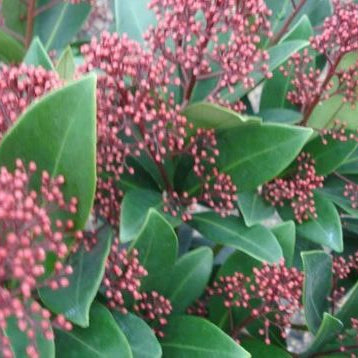
Free Delivery £400+*
Hedging, Tree, Shrubs & more
Free Delivery £400+*

Plants affected: The most affected are broad beans, roses, fuchsia and hollyhocks
Symptoms: Patches of irregular discoloration on the foliage and stems. On close inspection these are circular and tend to be dark orange, brown, yellow or red spots on the undersides of the leaves
Control: Remove infected material and burn or dispose of. Do not compost. Make regular check-ups to catch it early. If you want to use a chemical, select one containing mancozeb, penconazole or flutriafol.
Plants affected: Tends to affect broadleaf trees and shrubs, for example Acer, Fagus, and Carpinus. This fungus only attacks dead plant material. Symptoms: Small coral orange/pink raised spots that form after the branch has died. Dieback occurs and if the infection spreads down to the crown the whole plant may die Control: Prune out all the dead and dying branches cutting back into healthy stems, dispose of the rubbish to prevent the fungus from spreading. There is no chemical control
Plants affected: Most fruits and vegetables, ornamentals, shrubs and trees
Symptoms: Infects all top-growth parts of the plant which are usually stressed as a result of drought or nutrient deficiency. A common sign is grey mould on leaves, stems and flower buds. Before the mould appears, there could be dead brown patches on the leaves and rotting on some of the plant stems.
Control: Remove all dead and damaged plant material before it becomes infected. Begin a programme of watering and feeding and isolate infected plants if possible. You can use a chemical containing myclobutanil or penconazole
Plants affected: Can be found on shrubs and roses
Symptoms: Leaves are marked with purple or brownish black spots that turn yellow and cause premature leaf drop. Smaller spots can also discolour the stems and after a while the plant will weaken
Control: Affected leaves must be promptly destroyed along with any stems that show signs of infection. The best way to prevent black spot is to lay a thick mulch around the plants. This helps to lock the moisture in the ground and reducing evaporation of moisture from around the roots. Spray with a fungicide containing myclobutanil fortnightly from early Spring, just as the new foliage emerges
Plants affected: Can find it on apples, pears, rowan, beech and other broad-leaved trees. Spread is by rain splash.
Symptoms: Leafless shoots or twigs with sparse, small foliage. Bark that is sunken or distorted. Stems can be cracked and swollen and bear small red or white pustules
Control: During dry conditions only, use clean, sharp secateurs to prune out the infected area to new healthy growth, making sure that you sterilise the secateurs after each cut to minimise spread. Thoroughly clean the secateurs when you have finished. Spraying fungicides containing myclobutanil and mancozeb during Spring and Summer.
Plants affected: Found on clematis, usually the large, flowered cultivars.
Symptoms: The top of a clematis plant suddenly wilts, collapses and dies back. The problem quickly spreads down through the plant. Wilt spreads from a leaf, the stalk turns black. It is caused by a fungus that enters through a wound on soft growth made by plant ties or insects. It spreads by water splash.
Control: Cut back affected stems to healthy growth, even if it means cutting below ground level. Clear away all infected parts and mulch around where the new shoots will appear. The clematis should send up fresh new shoots. If the problem returns, replant deeply in rich fertile, well-drained soil, mulch the area with slate or gravel to keep it cool
Brenelia is a very hardy form of portuguese laurel that also grows a little faster, in a very tidy manner with much redder stems. More graceful in...
View full detailsThe posh form of laurel hedging. They cost a little more than common laurel but they are more graceful in appearance with purple shoots and finer l...
View full detailsPrunus lusitanica Angustifolia - Portuguese Laurel are fantastic laurels that are a great alternative to the classic cherry Laurel. They are more f...
View full detailsClassic laurel hedging. It's the country's favourite hedging shrub. Lovely luxurious evergreen bright green leaves. Grows easily in all soils excep...
View full detailsClassic laurel hedging. It's the country's favourite hedging shrub. Lovely luxurious evergreen bright green leaves. Grows easily in all soils excep...
View full detailsPrunus lusitanica Angustifolia - Portuguese Laurel are fantastic laurels that are a great alternative to the classic cherry Laurel. They are more f...
View full detailsPrunus Lusitanica - Portuguese Laurel are fantastic laurels that are a great alternative to the classic cherry Laurel. They are more formal in appe...
View full detailsClassic laurel hedging. It's the country's favourite hedging shrub. Lovely luxurious evergreen bright green leaves. Grows easily in all soils excep...
View full detailsClassic laurel hedging It's the country's favourite hedging shrub. Lovely luxurious evergreen bright green leaves. Grows easily in all soils excep...
View full details